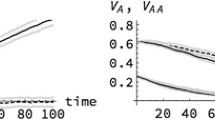Summary
The phenotypes associated with the nine genotypes in a quantitative genetic system consisting of two loci, each having two alleles can be described in terms of nine parameters, giving a system of nine linear equations. Populations with desired magnitudes and known nature of intra- and interlocus interactions are obtained by the use of this linear combination model. The total sums of squares for genotypes in these populations are partitioned into orthogonal components denoting additive and dominance effects of the two loci and the four types of nonallelic interactions between them. In most cases, the relative magnitudes of dominance and epistatic variances are found to be considerably smaller than the actual proportions of these genetic effects. Duplicate interaction produces larger epistatic variance than complementary type of gene interaction. At the higher levels of epistasis, dominant epistasis yields much larger epistatic variance than recessive epistasis. No epistatic variance is produced in the absence of epistatic effects. But, appreciable contributions of additive and dominance gene actions to the total genotypic variability are obtained even in the complete absence of these effects, if additive × dominance and dominance × dominance epistatic effects, respectively, are present. It is concluded that in elucidating the nature of gene action in simplified genetic systems, the estimates of first degree parameters obtained from the linear combination model are more useful than the orthogonal components of genotypic sum of squares.
Zusammenfassung
Die in einem quantitativ-genetischen System mit je 2 Allelen an 2 Loci möglichen 9 Phänotypen, die mit den entsprechenden Genotypen assoziiert sind, können durch einen Satz von 9 linearen Gleichungen beschrieben werden. Mit Hilfe dieses Modells der linearen Kombination wurden Populationen mit willkürlich gewählter Dimension und Art der Interaktion innerhalb der und zwischen den Loci konstruiert. Die Gesamtsummen der Abweichungsquadrate für die Genotypen derartiger Populationen werden in orthogonale Komponenten zerlegt, die den additiven und den Dominanz-Effekten bzw. den vier Arten der nichtallelen Interaktion der beiden Loci zugeschrieben werden können. In der Mehrzahl der Fälle sind die relativen Größenordnungen der Dominanz- und Epistasie-Varianzen wesentlich kleiner als die tatsächlichen Anteile dieser Effekte. Eine gegenseitige Vertretbarkeit nichtalleler Gene (duplicate gene action, 15:1-Spaltung) führt zu einer größeren Epistasievarianz als komplementäre Genwirkung (9:7-Spaltung). Bei stark ausgeprägter Epistasie führt die sog. dominante Epistasie (12:3:1-Spaltung) zu einer wesentlich größeren Epistasievarianz als die rezessive Epistasie (9:3:4-Spaltung). In Abwesenheit epistatischer Effekte wird keine Epistasievarianz beobachtet. Jedoch werden bemerkenswerte Beiträge additiver und dominanter Genwirkungen zur genotypischen Gesamtvariabilität auch bei völliger Abwesenheit derartiger Wirkungen beobachtet, wenn Interaktionen des Typs additiv × dominant bzw. dominant × dominant vorliegen. Hieraus wird geschlossen, daß die Aufklärung der Art der Genwirkung in einfachen genetischen Systemen gezeigt hat, daß die Schätzwerte der Parameter 1. Grades, die aus dem zitierten Modell mit linearer Kombination erhalten werden können, brauchbarer sind als die orthogonalen Kombinationen der genotypischen Summe der Abweichungsquadrate.
Similar content being viewed by others
References
Cockerham, C. C.: An extension of the concept of partitioning hereditary variance for analysis of covariances among relatives when epistasis is present. Genetics39, 859–882 (1954).
Crow, J. F., Kimura, M.: An introduction to population genetic theory. New York: Harper & Row 1970.
Fasoulas, A. C., Allard, R. W.: Nonallelic gene interactions in the inheritance of quantitative characters in barley. Genetics47, 899–907 (1962).
Fisher, R. A.: The correlation between relatives on the assumption of Mendelian inheritance. Trans. Roy. Soc. Edinburgh52, 399–433 (1918).
Jana, S.: Simulation of quantitative characters from qualitatively acting genes. I. Nonallelic gene interactions involving two or three loci. Theoret. Appl. Genetics41, 216–226 (1971).
Jana, S.: Biometrical analysis with two or three gene loci. Can. J. Genet. Cytol. (In press.)
Lee, J. A., Cockerham, C. C., Smith, F. H.: The inheritance of gossypol level inGossypium. I. Additive, dominance, epistatic, and maternal effects associated with seed gossypol in two varieties ofGossypium hirsutum L. Genetics59, 285–298 (1968).
Mather, K.: Complementary and duplicate gene interactions in biometrical genetics. Heredity22, 97–103 (1967).
Persson, G.: Diallel analysis of ear internode length in barley. Hereditas63, 39–47 (1969).
Persson, G.: Diallel analysis of ear internode length in barley. Proc. 2nd Inter. Barley Genet. Symp., Pullman (1971).
Russell, W. A.: Types of gene action at three gene loci in sublines of a maize inbred line. Can. J. Genet. Cytol.13, 322–334 (1971).
Russell, W. A., Eberhart, S. A.: Effects of three gene loci in the inheritance of quantitative characters in maize. Crop Science10, 165–169 (1970).
Seyffert, W.: Die Simulation quantitativer Merkmale durch Gene mit biochemisch definierbarer Wirkung. Züchter36, 159–162 (1966).
Stewart, J.: Biometrical genetics with one or two loci. I. The choice of a specific genetic model. Heredity24, 211–224 (1969).
Thoday, J. M.: Location of polygenes. Nature191, 368–370 (1961).
von der Pahlen, A., Goldenberg, J. B.: Effects of individual genes on quantitative characters in barley. Proc. 2nd Inter. Barley Genet. Symp., Pullman (1971).
Wilson, F. D., Lee, J. A.: Genetic relationship between tobacco Budworm feeding response and gland number in cotton seedlings. Crop Science11, 419–421 (1971).
Author information
Authors and Affiliations
Additional information
Communicated by W. Seyffert
The investigation was supported by the grant number A6221 of the National Research Council of Canada.
Rights and permissions
About this article
Cite this article
Jana, S. Simulation of quantitative characters from qualitatively acting genes. Theoret. Appl. Genetics 42, 119–124 (1972). https://doi.org/10.1007/BF00583413
Received:
Issue Date:
DOI: https://doi.org/10.1007/BF00583413




